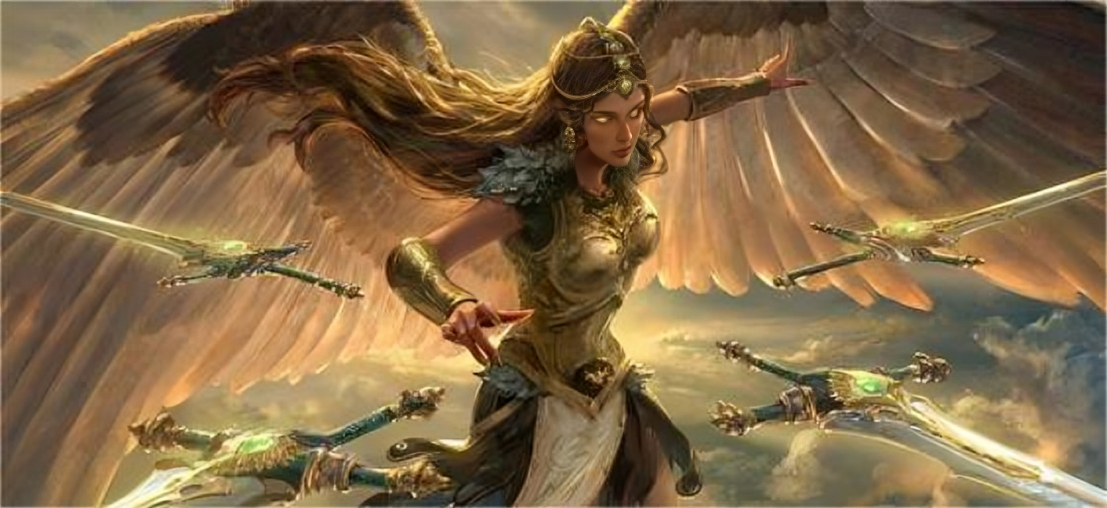Nilsa
Seraph of the Blade Nilsa (a.k.a. The Traitor Queen, Fourfold Flame)
Creation and Purpose
Nilsa was one of the first five angels forged in 19992 BCE by the goddesses Xelene and Randia in response to the rise of Celian Maleficium and her demonic empire. Unlike many of her kin, Nilsa was not merely a warrior - she was a symbol of divine balance.
Each of her four blades represented a pillar of celestial guidance:
- Discipline, to resist temptation
- Mercy, to preserve life
- Wrath, to deliver righteous judgment
- Resolve, to stand unyielding against darkness
She was the youngest of the five angelic leaders, but quickly earned renown for her precision, passion, and commitment to justice. Mortals prayed to her name even before her fall.
Role in the Wars
Nilsa fought in all three Wars of Light and Darkness, rising from a disciplined champion to a feared and tragic legend.
First War (19990 – 19984 BCE)
Nilsa fought valiantly alongside Maccius, Leander, Astrea, and Solastra. Her style was graceful, efficient, and calculated. Though she survived the war, she was deeply shaken by Astrea’s death and the desecration of her body above the gates of Viremalas. This moment marked the beginning of her emotional shift.
Second War (19924 – 19893 BCE)
She returned fiercer, her blades burning brighter than before. During the Siege of Sarr'vasen, she was captured and held by demonkind for three days. Though she claimed to have resisted, her comrades noticed subtle changes: her fighting grew more passionate, even reckless. Her once-perfect balance faltered - Mercy began to dull.
Unbeknownst to the others, this event marked the start of her unraveling.
Third War (19885 – 19876 BCE)
By the final war, Nilsa was no longer the calm angelic warrior she once was. She burned with vengeance, and her hatred for Celian had grown… complicated.
It was during this time that her secret relationship with the incubus Sylix came to light.
The Fall and the Betrayal
In an effort to weaken the angelic host from within, Celian sent Sylix, a charismatic and cunning incubus, to seduce Nilsa. He succeeded - but instead of merely corrupting her, they fell in love. Their bond was not born from manipulation alone - it became genuine, if twisted by secrecy, guilt, and longing.
The affair lasted for decades, hidden even from her angelic siblings.
But two years before the Third War’s end, Nilsa made her choice.
During a key strategy council, she betrayed the celestial host, killing Maccius. She then fled to Kael’Dun and emerged days later wearing armor reforged in obsidian and wielding her four corrupted blades, now cracked and infused with abyssal light.
Her betrayal marked the collapse of divine resistance in the Third War. The gods did not send more angels. The mortal forces scattered. And Nilsa was never seen among the celestials again.
Relationship with Sylix
Nilsa and Sylix, though born of opposing forces, found in each other what neither could attain elsewhere: understanding. Sylix admired her strength, her discipline - while she craved the vulnerability he offered and the freedom to feel without judgment.
Celian, recognizing the union’s symbolism and power, married them in a ritual of binding and chaos. The unholy marriage shocked even her generals.
They had one child - a rare fusion of divine and demonic essence. As punishment for Nilsa’s betrayal, Randia turned the child to stone, declaring it an abomination. The statue still stands in Miamar, untouched and silently watching.
Some say Nilsa returns there, in secret, to weep.
Fighting Style and Abilities
Nilsa’s combat was defined by elegant control - each of her four magical swords channeled a different divine essence, allowing her to strike with varied elemental and emotional force. She could attack from four angles simultaneously, spinning through the air like a dance of radiant destruction.
After her fall, her swords fractured, but she continued to wield them - now laced with infernal energy, each one corrupting the virtue it once represented.
She remains one of the most feared warriors ever to walk Ebbavion, her very name used in stories to warn against arrogance, passion, and unchecked conviction.
Legacy and Symbolism
Nilsa’s fall is one of the most tragic and divisive stories in celestial lore.
To some, she is a cautionary tale - proof that even the brightest lights can be extinguished by love, pain, and doubt.
To others, she is a martyr of emotion, betrayed by her creators and condemned for daring to love.
Her swords remain highly sought-after relics. It’s said that whoever recovers and purifies them may find a path to redeem her - or to complete her fall.
Relationships

Symbols
A radiant sword split into four, now often depicted shattered or bleeding
Known Weapons
The Fourfold Blades – magical swords representing Discipline, Mercy, Wrath, and Resolve



Comments